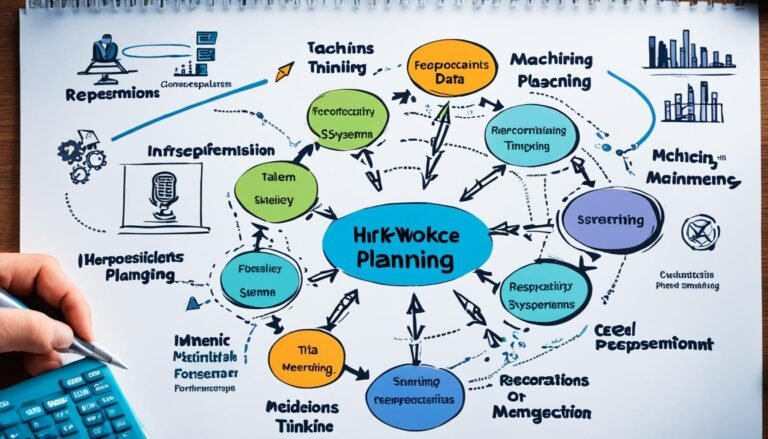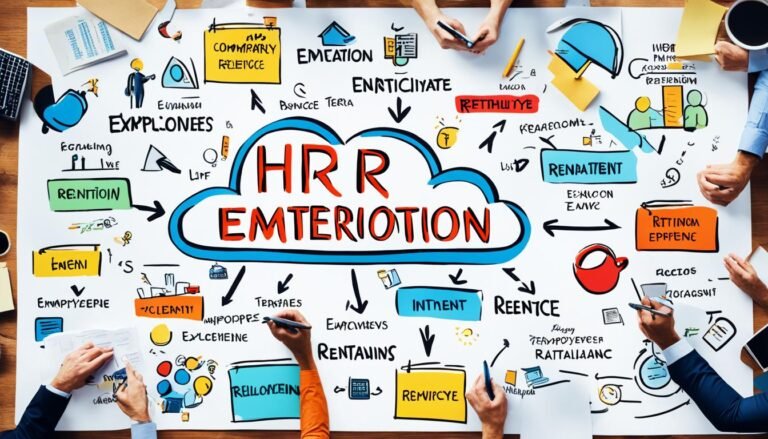Employee Performance: Coaching and Managing Bad Attitudes
When it comes to employee performance, coaching and managing bad attitudes require patience and skill.
Identifying negative behaviors is just the beginning; understanding the underlying reasons and setting clear expectations are essential steps.
But what happens when efforts to improve attitudes fall short despite your best attempts?
There might be a key strategy that can turn the tide and transform even the most challenging situations.
Key Takeaways
- Identify negative attitudes through body language and interactions.
- Understand root causes like work environment and personal issues.
- Set clear expectations and hold employees accountable.
- Communicate directly, listen actively, and resolve conflicts positively.
Identifying Negative Attitudes
To effectively identify negative attitudes in employees, observe their body language, tone of voice, and interactions with coworkers for early warning signs. Identifying patterns is vital in recognizing consistent behaviors that may indicate underlying issues. Pay close attention to non-verbal cues such as crossed arms, eye-rolling, or sighing, as these can often signal dissatisfaction or frustration.
When addressing concerns about negative attitudes, it's essential to approach the situation with empathy and understanding. Schedule a private meeting to discuss observations in a non-confrontational manner. Express your observations using specific examples and how these behaviors may be affecting the team dynamic or work environment.
Encourage open communication by allowing the employee to share their perspective. Listen actively to their concerns and work together to find solutions. It's important to provide constructive feedback and support to help the employee improve their attitude and performance. Remember, addressing negative attitudes early on can prevent larger issues from arising in the future.
Understanding Root Causes
When addressing employee performance issues, understanding the root causes is pivotal. By conducting an attitude impact analysis and identifying behavior triggers, you can pinpoint the underlying factors affecting performance.
This proactive approach allows you to tailor your coaching and management strategies effectively.
Attitude Impact Analysis
Understanding the root causes of attitude impact is essential for effective coaching and managing employee performance. When analyzing attitude impacts, consider the following:
- Work Environment: Evaluate how factors like workload, team dynamics, or organizational culture may be influencing the employee's attitude.
- Personal Circumstances: Take into account any personal issues or external factors that could be affecting the employee's behavior and mindset.
- Communication Styles: Assess how communication methods within the workplace may be contributing to misunderstandings or conflicts that impact attitude.
Behavior Triggers Identification
Identifying the triggers behind employee behavior is essential for effectively addressing performance issues and fostering a productive work environment. By recognizing behavior patterns and understanding what prompts certain actions, managers can tailor their coaching strategies to support employees better. Identifying triggers can range from stressors in the workplace to personal challenges affecting performance. Below is a table to help you understand how behavior triggers can impact employee performance:
| Trigger Type | Description | Impact on Behavior | Effective Management Strategies |
|---|---|---|---|
| Work Environment | Organizational culture and structure | Negatively affects productivity | Address any toxic work environment issues |
| Personal Factors | Individual circumstances and emotions | Influences attitude towards work | Provide support and resources for personal challenges |
| Lack of Communication | Poor communication channels | Leads to misunderstandings and conflict | Implement clear communication strategies and encourage open dialogue |
Identifying triggers and behavior patterns can empower you to address performance issues proactively and create a more positive work environment.
Setting Clear Expectations
When setting clear expectations for your team, it's important to establish clear performance standards, ensuring everyone understands what's expected of them.
Embrace a direct communication approach to convey these expectations effectively, leaving no room for ambiguity.
Hold each team member accountable for their behavior, fostering a culture of responsibility and excellence.
Clear Performance Standards
To effectively guide your employees towards success, it's essential to establish clear performance standards that outline specific expectations and objectives. Setting clear performance standards helps in providing a framework for performance evaluation and behavior modification. Here are three key points to contemplate when setting clear performance standards:
- Specificity: Clearly define what successful performance looks like for each task or goal.
- Measurability: Establish quantifiable metrics or indicators to evaluate progress and success.
- Feedback Mechanism: Create a system for providing timely feedback on performance against the set standards, enabling employees to track their development.
Direct Communication Approach
Establishing clear communication channels is key to effectively setting and conveying clear expectations to your employees in a direct manner. Essential listening plays an important role in this process. By actively listening to your employees, you demonstrate respect and understanding, fostering a culture of open communication.
When addressing issues or setting expectations, engage in conflict resolution with a positive attitude. Encourage open dialogue, seek solutions together, and remain focused on the desired outcomes. By approaching conversations with a problem-solving mindset and a willingness to understand different perspectives, you can navigate challenging situations effectively.
Accountability for Behavior
For effective management of employee performance, ensuring accountability for behavior is essential in setting clear expectations and fostering a positive work environment. When addressing behavior in the workplace, consider the following:
- Behavior Modification: Implement strategies to encourage positive behavior and discourage negative actions. Provide feedback and guidance to help employees understand the impact of their behavior on themselves and the team.
- Consequences Enforcement: Clearly outline the consequences of unacceptable behavior. Be consistent in enforcing consequences to demonstrate that all employees are held accountable for their actions.
- Regular Check-ins: Schedule regular check-ins to discuss behavior and performance. Offer support and guidance to help employees improve their behavior and meet expectations.
Providing Constructive Feedback
When offering feedback to your employees, focus on specific behaviors and their impact on goals and team dynamics. Constructive feedback should be aimed at fostering improvement and enhancing performance. Here are some strategies to help you deliver effective feedback:
| Feedback Delivery | Improvement Strategies |
|---|---|
| Be specific and objective | Encourage self-assessment and reflection |
| Offer feedback in a timely manner | Provide clear action steps for improvement |
| Focus on behaviors, not personalities | Recognize and praise progress and effort |
| Use a balance of positive and negative feedback | Establish open communication channels for feedback |
| Make feedback is constructive and actionable | Offer training and development opportunities for growth |
Developing Personalized Improvement Plans
When creating personalized improvement plans for your employees, consider utilizing goal setting strategies tailored to their specific needs and aspirations.
Individualized training methods can help address skill gaps and enhance performance in areas that require development.
Progress tracking tools will assist in monitoring advancements and adjusting strategies as needed to guarantee continuous growth and success.
Goal Setting Strategies
Consider setting specific and measurable goals when developing personalized improvement plans for employee performance. To enhance goal achievement and drive performance improvement, follow these strategies:
- SMART Goals: Make sure goals are Specific, Measurable, Achievable, Relevant, and Time-bound.
- Regular Check-ins: Schedule frequent meetings to track progress, discuss challenges, and provide support.
- Adjustment Flexibility: Be prepared to adjust goals based on feedback and changing circumstances.
Individualized Training Methods
To effectively develop personalized improvement plans for employee performance, implement individualized training methods tailored to each employee's specific needs and goals. By incorporating motivational incentives and personalized mentoring, you can enhance performance evaluation and skill development. Providing individualized training allows employees to focus on areas where they need improvement, leading to a more engaged and productive workforce. Below is a table to illustrate how personalized training methods can be tailored to different employee needs:
| Employee | Training Focus |
|---|---|
| John Smith | Sales Techniques |
| Emily Davis | Communication Skills |
| Michael Johnson | Time Management |
| Sarah Lee | Leadership Development |
Progress Tracking Tools
To develop effective personalized improvement plans for employee performance, incorporating progress tracking tools is important for ongoing assessment and targeted growth. Utilizing performance tracking tools allows for a structured approach to monitor progress and make data-driven decisions.
These tools provide valuable insights into areas of improvement and help employees stay accountable for their development. By tracking performance metrics regularly, you can identify patterns, trends, and areas that require attention.
Additionally, progress tracking tools facilitate behavior modification by offering a clear picture of performance changes over time. This data-driven approach enables managers to tailor coaching strategies to address specific behaviors effectively.
Encouraging Open Communication
Encouraging open communication within your team fosters trust and collaboration, leading to increased productivity and a positive work environment. Active listening plays a vital role in fostering open communication.
When you actively listen to your employees, you not only hear their words but also understand their feelings and perspectives. This practice helps in creating a safe space where team members feel valued and heard.
Additionally, promoting effective conflict resolution strategies is essential in encouraging open communication. Addressing conflicts openly and constructively can prevent issues from escalating and improve team dynamics.
Encourage your team to approach conflicts with a problem-solving mindset, focusing on finding solutions that benefit everyone involved.
Building Trust and Rapport
Building trust and rapport with your team members is crucial for fostering a positive work environment and enhancing collaboration. To effectively build rapport and trust within your team, consider the following:
- Active Listening: Show genuine interest in what your team members have to say. Listen attentively, ask clarifying questions, and demonstrate empathy to build trust through effective communication.
- Transparency and Consistency: Be open and honest in your interactions. Share information transparently, set clear expectations, and follow through on commitments. Consistency in your actions will help establish trust over time.
- Empathy and Support: Understand your team members' perspectives, challenges, and aspirations. Offer support, guidance, and encouragement when needed. Showing empathy and being there for your team fosters a sense of trust and camaraderie.
Implementing Positive Reinforcement
When fostering a positive work environment and enhancing collaboration with your team, incorporating positive reinforcement techniques can further motivate and empower your employees. Positive reinforcement involves providing rewards or recognition for desired behaviors, encouraging their repetition. By implementing motivation techniques effectively, you can boost morale, productivity, and overall team satisfaction.
To illustrate the impact of positive reinforcement, consider the following table:
| Positive Reinforcement Techniques | Description | Benefits |
|---|---|---|
| Recognition | Acknowledging good work | Boosts morale |
| Incentives | Offering rewards or bonuses | Increases motivation |
| Career Development Opportunities | Providing growth prospects | Enhances employee engagement |
Utilizing these techniques can create a supportive and encouraging work environment. Recognizing employees for their hard work, providing incentives for achieving goals, and offering opportunities for career advancement can all contribute to a motivated and engaged team. Remember, positive reinforcement is a powerful tool in shaping employee behavior and fostering a culture of continuous improvement.
Handling Conflict Resolution
To effectively manage conflicts within your team, employing structured communication strategies is essential for maintaining a positive and productive work environment. When handling conflict resolution, consider the following strategies and techniques:
- Active Listening: Demonstrate empathy and understanding by actively listening to all parties involved in the conflict. This helps in uncovering underlying issues and feelings that contribute to the conflict.
- Open Communication: Encourage open and honest communication among team members. Create a safe space where individuals feel comfortable expressing their concerns and opinions without fear of judgment.
- Conflict Resolution Techniques: Implement proven conflict resolution techniques such as negotiation, compromise, and collaboration. These methods help in finding mutually beneficial solutions and fostering a sense of teamwork within the group.
Monitoring Progress and Adjusting Strategies
As you monitor progress and adjust strategies within your team, regularly review performance metrics to track achievements and identify areas for improvement. Behavior modification is enhanced through progress monitoring, allowing you to make informed decisions on necessary adjustments. By consistently evaluating the performance data, you can pinpoint trends and patterns that may require intervention or support.
To facilitate this process, consider utilizing the following table to organize your progress monitoring efforts:
| Metrics to Track | Frequency of Review | Action Needed |
|---|---|---|
| Key Performance Indicators (KPIs) | Weekly | Adjust Strategies |
| Employee Engagement | Monthly | Provide Feedback |
| Customer Satisfaction | Quarterly | Implement Changes |
| Training Completion | Bi-Annual | Offer Support |
Frequently Asked Questions
How Can a Manager Effectively Address Negative Attitudes in a Team Member Who Is Resistant to Change?
When dealing with resistance management and attitude adjustment in a team member who resists change, approach with empathy, active listening, and clear expectations. Encourage open communication, offer support, and provide constructive feedback to foster a positive shift.
What Are Some Effective Ways to Address Underlying Mental Health Issues That May Be Contributing to a Negative Attitude in an Employee?
Imagine mental health as a garden; nurturing it boosts productivity. Addressing underlying issues with empathy and support can improve attitude and performance. Encourage open dialogue, provide resources, and consider professional help for a holistic approach.
How Can Managers Effectively Balance Setting Clear Expectations With Allowing for Individual Differences in Performance and Attitude?
You can effectively balance setting clear expectations by focusing on performance improvement and individual development. Provide guidance tailored to each employee's strengths and areas for growth. Encourage open communication and support to foster a positive work environment.
What Are Some Strategies for Providing Constructive Feedback to an Employee With a Negative Attitude Without Causing Defensiveness?
When addressing an employee's negative attitude, start with empathy and active listening. Use conflict resolution and communication techniques to provide constructive feedback. Offer support and resources for performance improvement and attitude adjustment. Remember, positive changes take time.
How Can Managers Address Conflicts Between Team Members That Stem From Differing Attitudes and Personalities?
Address team conflicts by fostering open communication. Encourage understanding of diverse personalities and attitudes. Implement conflict resolution strategies promptly. Promote team bonding activities to improve dynamics. Support individuals in finding common ground for effective collaboration.
Conclusion
To sum up, managing employee performance and coaching bad attitudes requires a proactive approach that addresses root causes and fosters a positive work environment. By setting clear expectations, providing constructive feedback, and implementing personalized improvement plans, you can help employees overcome negative attitudes and improve their performance.
Remember, building trust, using positive reinforcement, and handling conflicts effectively are key components in promoting a healthy workplace culture. Keep monitoring progress and adjusting strategies to make sure continued success. Remember, Rome wasn't built in a day.







